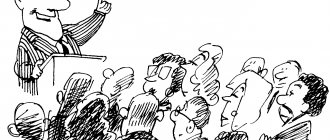logic - knowledge about the word as an instrument of thinking and activity.
Beginning of the performance
Usually, the speaker has the opportunity to be in advance in the place where he will speak, assess the fullness of the audience, the location of those gathered and mentally choose the place where everyone will see him, and he will see everyone, where it will be convenient for him to use auxiliary material, if any. It is also important to arrive in advance in order to assess the state of the listeners and decide whether it is necessary to use any method of establishing emotional contact with them, or whether those gathered are ready to perceive the information and will be completely satisfied with the friendly intonation.
In any case, when you walk confidently to the place where you are speaking, you should take an initial pause. A pause allows you to gather the views of the listeners and serves as an invitation to conversation.
The first phrase always contains a greeting. It doesn't have to be formal. If the speaker is happy to meet the audience, he has something to say to people, this will be reflected in the look he gives to those gathered, in his smile, in his friendly intonation. And, if not... then it’s better for him not to take the floor at all. After the initial pause and greeting, there is usually still some tension in the room, similar to what happens when a stranger enters the room. “What is he like? What will he say? What to expect from him? - think those present. Imagine now that the person who entered spoke in an official tone, stood as if made of wood and did not look at anyone. Everyone will run away from such a guest. What do listeners do in this case? They become isolated in their thoughts or find something to do. Therefore, “the first words of the lecturer,” said the outstanding judicial orator A.F. Horses must be extremely simple, accessible, understandable and interesting (they must distract, attract attention).” Moreover, they should not be pronounced into emptiness, but while looking at some listener you like. As soon as you see his reciprocal friendly gaze, • you need to turn your gaze to the other person and establish contact with him. The atmosphere in the hall will become warmer. The relationship has begun!
The first phrases that allow you to establish; emotional contact with the audience is called the opening.
There are many beginnings, these kind of catchy “hooks” of a speech: “... something unexpected, some paradox, some strangeness, as if not going to the point (but in fact connected with the whole speech), unexpected and not a stupid question, etc.”
The opening may be an appeal to the immediate interests of the listeners, drawing attention to the advertising title of the speech, an original quote, an intriguing description, an interesting fact, an impressive figure, a question or even a chain. Feeling that the attention of the listeners has been won, you can move on to an introduction to the topic.
An example of a smooth transition from the beginning, which is a colorful description, to the introduction to the topic, which informs about the plan for the upcoming speech - the introduction to the popular lecture by Professor M.A. Menzbier “The History of the Mediterranean Sea, Told by Its Shores, Waves and Their Inhabitants,” which he read on December 13, 1884 at the Polytechnic Museum: “Imagine yourself as a traveler who comes to the Mediterranean Sea for the first time, for the first time sees the blue of its waves, the distant coastal shores shrouded in haze rocks, lush green vegetation, and let me give you a brief description of the modern Mediterranean coast, starting with its geographical outline.”
So, in general, the introduction consists of two parts: the beginning and the introduction to the topic. The objectives of the introduction are to arouse interest in the speech and capture the attention of the audience, while ensuring that involuntary primary attention develops into conscious concentration; establish rapport and gain the trust of listeners.
Ways to keep your attention
An introduction can captivate listeners. But how can we maintain their attention throughout the entire speech in order to “... avoid a situation where a quarter of the listeners are busy “digesting” the content of the speech, and three-quarters are struggling with sleep”?
First of all, the logical organization of speech (consistency, consistency, validity) contributes to maintaining attention. In this case, the speaker leads the audience's thoughts along with him. Listeners are attracted by the structure of the presentation, in the course of which questions arise, and answers to them are born in the process of joint search or subsequent presentation. Maintaining the attention of the audience is facilitated by a problematic situation in speech, the presentation of facts or ideas in opposition.
Listeners follow with intense attention a performance in which new content is constantly being revealed in the material presented. If a speech contains nothing new, it not only goes unnoticed, but also causes a feeling of frustration and irritation in the audience. Therefore, the most important condition for maintaining attention to a speech is its content, that is, new information unknown to listeners or an original interpretation of known facts, fresh ideas, analysis of a problem.
The presentation must be accessible, which is largely due, as already mentioned, to the speaker’s speech culture. The inclusion of terms and ways of defining concepts are thought out in advance. The use of examples and visual aids, artistic means of language, a rational combination of theoretical principles with facts, and pauses to comprehend what is heard helps to make the speech understandable and intelligible.
The expressiveness of the speaker’s speech is capable of captivating listeners - changing intonation, colorful verbal images, original comparisons, apt expressions.
“You must have the dexterity to snatch out the most important and necessary and, just as quickly as my speech flows, clothe your thought in such a form that would be accessible to the understanding of the hydra and would arouse its attention, and you must vigilantly ensure that thoughts are not conveyed as they are accumulation, but in a certain order...” In addition, the various presentation techniques discussed earlier support attention. They are pronounced with different intonations, and this also enlivens the speech. Dialogue of speech, question-and-answer moves, and addressing the audience are so effective that they can save the situation when the audience begins to fall asleep.
O. Ernst also advises using dramatization of speech: an emotional and visual depiction of events related to the topic. This technique was used by the ancient Greek orator Aeschylus in his speech against Demosthenes in the famous dispute about the golden wreath: “...Imagine: walls are collapsing, hail is falling, a house is in flames, elders and wives, forgetting forever that they were once free, and rightly indignant not so much at the weapons, as many as at the perpetrators of their troubles, they cry out to you, begging you with tears: do not give a wreath to the destroyer of Greece...”
Experienced speakers who have an excellent command of the topic sometimes resort to provocation - they say something that causes disagreement of the audience (and, therefore, attracts their attention), and then, together with it, come to constructive conclusions.
Also, when performing, it is worth remembering a few simple rules:
What is public speaking
Public speaking is a complex concept that combines speaking in front of an audience, in open areas, on television, as well as communication with management, an employer, and just friendly communication in the company of good friends. Knowledge of the psychology of public speaking will be useful in any situation where you need to show your best qualities, demonstrate your ability to communicate, and present your professional skills. A successful oral speech is not just a conversation, but a signed contract, a new job, business partners, and recognition from society. The purpose of a public escapade is to interest the audience, so that listeners catch your every word, gesture, react to the intonations of your voice, this is the ability to inspire people with your ideas.
If we talk about pragmatic broadcasting to an audience, as a form of business communication, it is influencing the audience not only with words, but also with posture, facial expressions, gestures, pauses, rhythm of speech, visual contact, and strength of voice. This requires the speaker to master his own voice, body, facial expressions, follow special rules and use specific techniques.
Not every person can master such an art. From our material you will learn what public speaking is, its types and forms, and how to speak successfully in front of an audience.
Start with the introduction
People decide in the first 30-60 seconds of a presentation whether to listen to you or scroll through their social media news feed, so you need to practice building a strong start to your speech. The best ways to grab the audience's attention is to start your speech:
- by telling a story or using a quote;
- with a statement of the importance of the topic.
On the contrary, the fastest ways to turn off your audience's attention are:
- define terms;
- tell a weak or untested joke;
- talk about yourself.
Be sure to come up with and test different presentations that will help your audience connect to the topic of your talk.
Types and forms of public speaking
Types:
- informational speech - used in reports on political or scientific topics, lectures for students, speeches to students, stories about any phenomenon;
- protocol and etiquette - in this form delegations are welcomed, congratulations on the birthday or anniversary are prepared, opening or closing remarks at an official event;
- entertaining - any informal speech (toast, life story about a funny incident);
- persuasive - the main goal is to convince listeners that the speaker is right, to demonstrate the correctness of the position and judgments, used in commercials, political and scientific discussions, and propaganda programs.
Important! One speech can have different goals, as a result, the types of speeches to the public are combined and the results are information-persuasive or information-entertaining.
Forms of speaking to an audience:
- report - an address on an important topic (social, scientific, medical), duration from a quarter of an hour to 3 hours;
- message - a short speech dedicated to one topic, maximum duration 10 minutes, must contain facts and statistical information;
- speech - a short message lasting up to 5 minutes, the topic is chosen in advance or arises as a result of discussion of a specific topic;
- lecture - presentation of a specific topic by a specialist using scientific facts, duration ranging from a quarter of an hour to 1.5 hours;
- conversation - a dialogue between the lecturer and the audience, the topic and format are determined in advance, is not limited to a time frame, involves questions from the audience, and answers from the speaker.
Strive to help your audience
Most speakers consider the goal of their speech to be immediate benefit: for example, promoting a website or service, expanding the circle of clients.
Thinking about performing in this way adds pressure to an already stressful situation. Instead, strive to ensure that your speech is useful to the audience.
When you help people grow professionally or try to improve their lives in some way, you already receive benefits in the form of loyal listeners, fame and new clients.
Be brief
If you are given 30 minutes to speak, use 25. If you are given an hour, speak for 50 minutes. Always respect your audience's time and finish early.
By trying to shorten your speech during the preparation stage, you will hone your speech and remove everything unnecessary from it.
Finish early and spend the remaining time answering questions from the audience. If there is not enough time, invite the audience to meet after the presentation to discuss any unclear points.
Never delay your presentation. This can ruin the positive impression and leave a bad taste in the audience's mouth.
Content
- The purpose of the speaker
- Checklist for preparing for a public speaking Analysis of the target audience
- Purpose of the speech
- Choosing a theme
- Preparation of notes
- Presentation for public speaking
- Preparing for the audience's reaction
- Oral speech production
- Contact with the audience
- Lyrical digressions
- Emotionality
- Working on anxiety
- Timing
- Rehearsals
- Before going on stage
- Experience is the son of difficult mistakes
- Introduction
Pause for 10 seconds
Stop for 2 seconds and the audience will think you've lost your point. Pause for 5 seconds and the audience will think you paused on purpose. After a 10-second pause, even those who were texting while you spoke will look up to see what's going on.
When you start speaking again, everyone will be confident that your pause was intentional and that you are a confident and accomplished speaker.
An insecure storyteller fears emptiness, and only an experienced speaker feels comfortable in silence. Take one long pause to collect your thoughts and the audience will automatically give you points.









